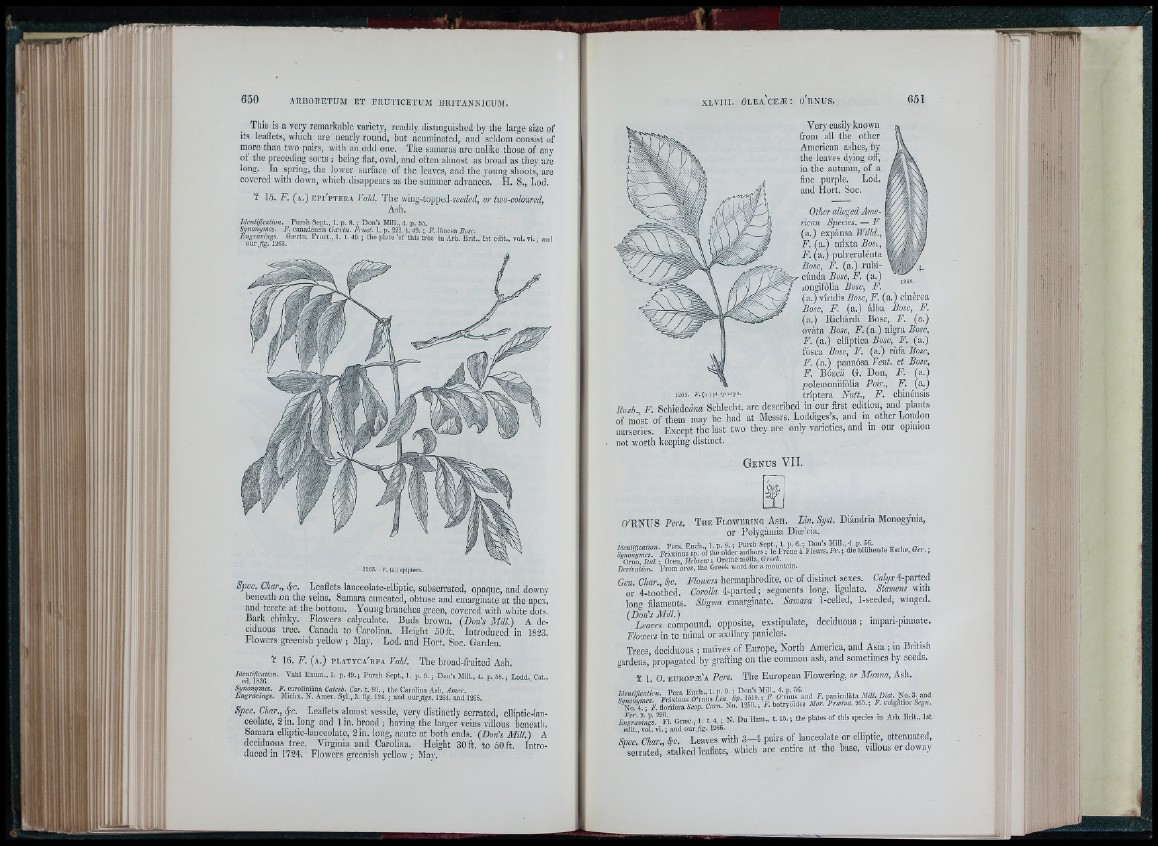
í i'Í! i
i ; I I ¡' i) Ij !
This is a very remarkable variety, readily distingui.shed by the large size of
its leaflets, which are nearly round, but acuminated, and seldom consist of
more than two pairs, with an odd one. The samaras are unlike those of any
of the preceding sorts ; being flat, oval, and often almost as broad as they are
long. In spring, the lower surface of the leaves, and the young shoots, are
covered with down, which disappears as the summer advances. H. S., Lod.
¥ 15. F . ( a . ) e p i ' p t e r a Fahl. The wing-topped-iiiflf/FZ, or tivo-coloured.
Ash.
Ideniification. Pursh Sept., 1. p. 8. ; Don’s Mill., 4. p. 5.5.
Synonymes. F. canadénsis Gecrtn. Fruct. 1. p. 222. t. 49. ; F. láncea Bosc.
*of this tree In Arb. Brit.. 1st edit., v o l.v i.; and
1263. F . (a.) epiptera.
Spec. Char., 4c. Leaflets lanceolate-elliptic, subserrated, opaque, and downy
beneath .on the veins. Samara cuneated, obtuse and emarginate at the apex,
and terete at the bottom. Young branches green, covered with white dots.
Bark clunky. Flowers calyculate. Buds brown. (Doris Mdl.) A deciduous
tree. Canada to Carolina. Height 50 ft. Introduced in 1823.
Flowers greenish yellow ; May. Lod. and Hort. Soc. Garden.
¥ 16. F . ( a . ) p l a t y c a ' r p a Vahl. The broad-fruited Ash.
Synonymes. F. caroliniàna Catesb. Car. t. 80. ; the Carolina Ash, Amer.
Engravings. Michx. N. Amer. Syl., 3. fig. 124.; and o u r ^ s . 1264. and 126.5.
Spec. Char., f r . Leaflets almost sessile, very distinctly serrated, elliptic-lanceolate,
2 in. long and 1 in. broad ; having the larger veins villous beneatli.
Samara elliptic-lanceolate, 2 in. long, acute at both ends. {Doris Mill.) A
deciduous tree. Virginia and Carolina. Height 30 ft. to 50 ft. Introduced
in 1724. Flowers greenish yellow ; May.
à
Very easily known
from all the other
American ashes, by
the leaves dying off,
in the autumn, of a
fine purple. Lod.
and Hort. Soc.
Other alleged Awe- \
rican Species. — F \
(a.) expansa Willd., |
F. (a.) mixta Bosc, |
F. (a.) pulverulenta
Bosc, F. (a.) rubicunda
Bosc, F. (a.)
longìfòlia Bosc, F.
(a.) viridis Bosc, F. (a .) cinèrea
Bosc, F. (a.) állia Bosc, F.
(a.) Richárdz Bosc, F. (a.)
ovata Bosc, F .(a.) nigra .Bosc,
F. (a.) elliptica Bosc, F. (a.)
fúsca Bosc, F. (a.) rùfa Bosc,
F. (a.) pannòsa Vent, et Bosc,
F, BÓSCÜ G. Don, F. (a.)
polemoniifòlia Pair., F. (a.)
triptera 1261. F . (a.lpl.tixiti-pa. Nutt., F. chinénsis
llilUoXxbO ., BF. oSCcIhiiiceUdUetot«M«' Schlech>t..• ia.irfee- —described in'our first edition, and fpe la-nts
of most of them may be had at Messrs. Loddiges s, and in other London
nurseries. Except the last two they are only varieties, and in our opinion
not worth keeping distinct.
G e n u s VII.
" I
0'R.NUS Pers. T h e F l o w e r i n g A s h . Lin. Syst. Diandria Monogjnia,
or Polygmiiia Dioe'cia.
Esche, G rr.;
Orno, Ital. ; Oren, Hebrew ; Orerae melia, Greek. _
Derivation. From oros, the Greek word for a mountain.
Gen Char 4c. Flowers hermaphrodite, or of distinct sexes. Calyx 4-parted
or 4-toothed. Corolla 4 -p a r te / segments long, ligulate. Stamens with
long filaments. Stigma emai'ginate. Samara 1-celled, 1-seeded, winged.
(Don’s Mill.) . . . .
Leaves compound, opposite, exstipulate, deciduous ; irapari-pmnate.
Flowers in te minai or axillary panicles.
Trees deciduous ; natives of Europe, North America, and Asia ; in Briti.sh
gardens,’propagated by grafting on the common ash, and sometimes by seeds.
Î 1. O. e ü b o p æ 'a Pers. The European Flowering, or Manna, Ash.
Pers. E u e / t o t o . » 'o 'rn u s and F. paniculàta Mill. Bict. No. 3. and
"So 4 fl? r ilr â A Cor«. No 1260. ; F. hotryiildes Mer. FrxluC. 265.; F. vulgatior Seen.
E n g ra rta ls .^ F l. Græc.. 1. t. 4. ; N. Dn Ham., t. 15. ; the plates of this species in Arb. Brit., 1st
edit., vol. vi. ; and o u r /g . 1266.
Spec. Char., f r . Leaves with 3—4- pairs of lanceolate or elliptic, attenuated,
serrated, stalked leaflets, which are entire at the base, villous or downy
li .
{ <